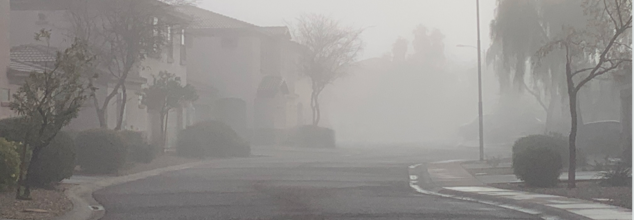- Health Conditions A-Z
- Health & Wellness
- Nutrition
- Fitness
- Health News
- Ayurveda
- Videos
- Medicine A-Z
- Parenting
- Web Stories
Mysterious Fog That 'Smells Like Chemicals'- Natural Phenomenon Or Cause For Concern?

Image Credit: Canva (representational only)
A heavy fog that "smells like chemicals" has been covering several parts of the United States lately, raising health concerns for people exposed to it. Reports have described sore throats and coughing, fatigue, and eye irritation among the exposed. But why does this fog smell so weird, and why are some people falling ill?
In this article, we will explore the science behind this phenomenon, how fog forms, and why it might sometimes carry chemical odors that linger in the air. By the end, we will also debunk some of the more speculative claims that have surfaced in the wake of this mysterious fog event.
The ‘Chemical Fog’ and Its Health Impacts
The fog has started trending on social media, with multiple users saying that it smells of fireworks, chemicals, or even sewage. David Bamber of St. Petersburg, Florida, shared a very popular TikTok video describing the sensation of walking through the fog and having the feeling of inhaling something toxic. Others reported developing respiratory conditions, including sore throats, coughs, and general fatigue, which they blamed directly on the fog. In fact, a Florida resident described how, following a short detour at a gas station, she started sneezing uncontrollably and became feverish, with stomach cramps as well. For some, this "sickness-fog" has become an urgent health issue.
As alarming as this is, the mist might not seem so evil. After all, there are scientifically established reasons about how fog functions with its surroundings, especially relating to pollutants, which could strengthen the odor it has.
Fog Formation and Its Chemical Absorption
This takes place when the water vapor present in the air condenses to become small water droplets and eventually form a low-lying cloud, making visibility hard to perceive. Such droplets will act as natural scavengers absorbing all airborne pollutants and particles. Moisture contained within the fog will amplify the concentration of pollutants such as chemicals and odors to make them much stronger and hence easily noticed.
According to Washington University atmospheric scientist Professor Rudolf Husar, chemicals trapped within the fog droplets "include sulfur oxides and nitrogen oxides, gases primarily produced by industrial activity, vehicle emissions, and, more rarely, natural fires. Those chemicals stay in the air a long time, especially because when they are trapped in these droplets, they become concentrated and kindle chemicals and odors in the surrounding environment.". This process is known as "scavenging," where fog droplets absorb gases and pollutants, allowing them to linger longer than they might in clearer air.
Also Read: Health Concerns Rise As US, Canada, and UK Come Under The Blanket Of Thick, Dense, Toxic Fog
The reason why this fog smells so potently is that humidity increases the way smells move. When water molecules in the air combine with odor-causing molecules, they tend to last longer and thus become more pronounced to our noses. This explains why some people have reported that the fog smells like chemicals or even like sewage, depending on the surrounding environment's air quality.
What Role Does Atmospheric Conditions and Pollutants Play?
More than just an atmospheric visual appearance, fog could often trap most kinds of pollutants when the ground-adjacent layers are extremely cold, often experienced during the cold season. As it douses many inhabited spaces, pollution is able to cling with the fog through smokes emitted from vehicles, factory chemicals, among other things. When people inhale this "chemical fog," they may feel irritation in the respiratory system. It is particularly more sensitive to individuals with pre-existing conditions, like asthma, who have airways that are easily irritated by a change in air quality.
In addition, air pollution generally causes a variety of health issues, from simple coughing and congestion to severe respiratory problems. The moisture of the fog increases these effects, introducing more water into the lungs and causing irritation. This is why some people may feel shortness of breath, chest pain, or even experience wheezing when exposed to dense, polluted fog.
Fogs often occur where, for instance, Florida regions do, following a specific set of weather, often temperature inversion. In cases of temperature inversions, there will be cooler air trapped very close to Earth by warmer air over it so that pollutants from whatever source have less space to dispel into the atmosphere. That accumulated pollutant within the fog contributes to having that chemical even more pungent.
Besides pollution, local moisture sources heavily influence fog. For example, areas next to large bodies of water like the San Francisco Bay often see thick fog in summer months as the water chills the surrounding air. However, in some areas, fog can form where moisture from the ground is evaporating into the air, condensing, and forming thick fog near the surface. Moisture, once condensed, can absorb pollutants and enhance existing odors.
Is There a Conspiracy Behind the Fog?
As the fog event has continued, some people have begun to speculate that there might be a more sinister or secretive explanation for the phenomenon. Conspiracy theories have been circulated, suggesting that the fog could be the result of a chemical weapon or even a government experiment. Such claims have largely been fueled by comparisons to Operation Sea Spray, a controversial U.S. The Navy biological warfare experiment in the 1950s where bacteria were released in the San Francisco Bay area to test the city's vulnerability to biowarfare.
Also Read: When Fear Clouds Judgment- The Psychology Behind The Mysterious Fog Over US And Canada
Even if the thought of a planned chemical fog, produced by humans, is quite threatening, science cannot prove such an idea. In fact, according to experts, the cause for the fog may simply be a part of the regular weather, in combination with higher concentrations of pollutants from human sources. Chemicals in the air, specifically sulfur and nitrogen compounds, are nothing but by-products of industrial pollution, not some sort of deliberate attack.
Why Does Fog Smell Like Chemicals?
In summary, the chemical-like odor produced by fog is a result of various environmental and atmospheric conditions. Due to fog's natural collecting characteristic, pollutants are trapped inside the fog droplets, which are very small in size. Thus, these pollutants include sulfur and nitrogen oxides, which are usually derived from vehicle emissions, industrial processes, and even wildfire cases. The moisture in the fog makes these odors more observable and potent.
Fog is not dangerous in itself, but the pollutants it captures can cause irritation to the respiratory system, especially for people who have pre-existing health conditions. Knowing how fog forms and how it interacts with its surroundings will help us prepare better for the effects of fog and address health concerns that may be triggered.
Even if this recent bout of fog caused concern, there's scientific logic for why this situation is not to be worried about. Nonetheless, being cognizant and knowing the quality of air is also a form of mitigation from this thick chemical smell fog that affects health.
Symptoms of Mpox: New Strain Spreading in the UK Prompts Health Warning

Credits: Canva
UK health officials have urged those at risk to get vaccinated against mpox as a particular strain of the virus continues to spread across parts of Europe. The UK Health Security Agency (UKHSA) has confirmed a small number of locally acquired cases of a strain known as clade Ib in the USA, Spain, Italy, the Netherlands, and Portugal, all of which have no travel links to regions with known outbreaks. This indicates that community transmission of the disease is now taking place globally.
Most of the newly reported infections in Europe and the USA have been identified among gay, bisexual, and other men who have sex with men, a group where transmission of this specific strain has not previously been observed.
New Strain Of Mpox Spreading In UK
According to a recent UKHSA update, as of October 20, 2025, a total of 16 clade Ib mpox cases have been detected in the UK, all of them in England. So far, there is no evidence of sustained transmission within the community of men who have sex with men. Nearly all cases have been linked to international travel to regions where community spread has been recorded, except for one case in which the source of exposure remains uncertain.
What Is ‘Clade Ib’ Mpox?
Clade Ib is a newer variant of the mpox virus (MPXV) that first emerged in the Democratic Republic of Congo in 2023. Since then, it has spread to other parts of Africa and beyond. The variant belongs to clade I, which is considered more severe, but clade Ib is thought to be more easily passed from person to person, particularly through sexual or close physical contact. Infections caused by this strain have been linked to more intense symptoms and a higher fatality rate, especially among children, pregnant women, and individuals with weakened immune systems.
Common Symptoms Of The Mpox Virus Spreading In The UK
According to the World Health Organization, the first signs of mpox often include:
- High fever
- Headache
- Muscle and back pain
- Swollen lymph nodes
- Chills
- Fatigue
- Joint pain
A rash typically appears within one to five days after the onset of these symptoms. It may show up on various parts of the body, including the hands, feet, mouth, genitals, and anus. Symptoms usually resolve within a few weeks, but the infection can spread to others while these signs are present.
As noted by health agencies, most of the recent cases in Europe and the United States have been reported in the gay, bisexual, and men who have sex with men population, a group that had not previously seen transmission of this particular strain.
Urgent Need For Mpox Vaccination
The UKHSA has renewed its call for eligible individuals to come forward for mpox vaccination. The agency has also confirmed limited local transmission of clade Ib cases in the USA, Spain, Italy, the Netherlands, and Portugal, noting that this reflects a broader pattern of community spread worldwide.
In its statement, the UKHSA explained that most of the recently confirmed cases in Europe and the USA have occurred in gay, bisexual, and other men who have sex with men, a group in which transmission of clade Ib mpox had not been observed before.
The spread of this variant beyond endemic regions such as parts of Africa has prompted heightened global surveillance. In August 2024, the World Health Organization declared mpox a global health emergency. Research suggests the existing vaccine offers about 75 to 80 percent protection against clade II mpox. Although specific data on its effectiveness against clade Ib are not yet available, experts believe it will still provide protection. A large number of people in eligible groups across the UK have already received their vaccination.
What Are Breast Mice? The Strange Breast Lumps That Can Cause Cancer Confusion

Credits: Canva
While we often hear about the importance of checking our breasts for any unusual lumps or changes, many women are now talking about another condition known as “breast mice.” The name might sound odd, but these are actually fibroadenomas, which are smooth, movable lumps that can shift under the skin when touched. They can occur at any age, though they’re more common in younger women. But are they cancerous? Discovering a lump in your breast can be alarming for anyone, but these “mice” are a harmless, non-cancerous breast condition that usually doesn’t require treatment.
What Are Breast Mice?
The term “breast mice” is a nickname for fibroadenomas which are benign (non-cancerous) breast lumps that move easily under the skin. The name comes from their tendency to slip away when you press on them, almost like a small mouse running off.
A fibroadenoma is a smooth, solid lump made up of both fibrous and glandular tissue. In most cases, it is completely harmless, though in very rare situations, a fibroadenoma may contain cancerous cells, according to the Cleveland Clinic.
In many cases, fibroadenomas shrink or disappear on their own. Your doctor may monitor them over time or, if necessary, suggest surgery to remove the lump.
What Are the Types of Fibroadenomas?
There are two main kinds of fibroadenomas:
Simple fibroadenomas are the most common type. They are smaller and don’t increase your risk of breast cancer. Under a microscope, the tissue appears uniform, meaning the cells look similar throughout.
Complex fibroadenomas are more often found in women over 35 and tend to be larger. When examined, they may show some variation in cell appearance, and your doctor might notice small calcium deposits or cysts on a mammogram. These may slightly raise your risk of breast cancer compared to women with no breast lumps. Complex fibroadenomas make up about 15% of all cases.
What Do Breast Mice Look and Feel Like?
Breast mice can range from smaller than a marble to about the size of a golf ball. They often appear suddenly and usually stay the same size, though some may shrink or grow over time. The lumps are usually firm and rubbery, but some women find them difficult to locate precisely.
According to the Royal Women’s Hospital, if you press on the lump, it will likely move away from your fingers — hence the term “breast mouse.” Most fibroadenomas measure around 1 to 3 centimetres and are classified as simple fibroadenomas.
Why Do Breast Mice Appear?
Fibroadenomas typically develop during puberty and are most common in women in their twenties and thirties. They’re influenced by hormonal changes, which means they can change in size during the menstrual cycle or pregnancy.
Do Breast Mice Increase the Risk of Breast Cancer?
For most people, having a fibroadenoma doesn’t raise the risk of developing breast cancer. However, those diagnosed with a complex fibroadenoma may have a slightly higher risk.
If you are concerned about your breast health or notice any new lumps or changes, it’s best to consult your GP or breast specialist. Even though breast mice are usually harmless, staying alert to changes in your breasts is always the safest approach.
Choosing Health Insurance? Here’s A Guide That Will Help You In Handling The Waiting Periods

Credits: Canva
Before you buy a health insurance, it is important that you understand its waiting period first. What exactly is the waiting period for a health insurance? It is the time you must wait before your policy covers certain conditions or treatments.
The longest waiting period, especially for pre-existing conditions, can stretch up to four years, depending on the insurer and the policy you choose. This guide will help you to understand how exactly does this waiting period work. This guide will answer all your questions, including: the longest wait you might face, and effective strategies to reduce or manage them.
What is the Longest Waiting Period for Health Insurance?
The longest waiting period for health insurance, particularly for pre-existing conditions, can extend up to five years.
According to Insurance Regulatory and Development Authority of India (IRDAI) guidelines, the illness-specific waiting period cannot exceed three years. For pre-existing diseases, the waiting period cannot exceed five years.
Depending on the insurer and the specific health plan, the waiting period for these conditions typically ranges from one to three years.
How Can You Reduce the Waiting Period in Health Insurance?
While health insurance policies often come with a waiting period, it is possible to shorten or modify these restrictions by opting for certain covers, usually at an extra cost.
The options available for reducing the waiting period vary from various insurer, so it is important to check the specific details with your provider.
Here are some methods to help reduce the waiting period on your health insurance policy:
Choose a Policy with a Waiting Period Waiver
Some insurers offer waiting period waivers as add-ons or features within their health insurance plans. These waivers can help lower or even remove waiting periods for certain types of coverage.
For instance, a Pre-existing Disease (PED) waiting period waiver could reduce the waiting time for pre-existing conditions.
Add a Top-Up Plan
Top-up plans or riders are additional coverages that can be attached to your existing health insurance policy. These plans often come with reduced waiting periods and enhanced protection, helping you access benefits sooner.
Negotiate with Your Insurer
If you have a clean health history or have been a loyal customer, you can negotiate with your insurer to shorten waiting periods. Some insurers may consider such negotiations, especially for long-term policyholders.
Specialized Plans for Pre-existing Conditions
Certain insurers offer specialized policies with shorter waiting periods if you have a pre-existing condition not covered by regular plans. However, these plans usually have a higher premium to compensate for the increased risk.
Opt for Co-Payment
You can often reduce waiting periods by agreeing to a co-payment option, where you share a portion of the medical costs with the insurer. This arrangement lowers the insurer’s risk and may result in quicker access to coverage.
What are the Different Factors That Influence the Duration of the Waiting Period in Health Insurance?
The length of the waiting period in health insurance is shaped by several elements, which can vary depending on the policy type, the insurance provider, and specific health conditions.
These factors determine how long policyholders must wait before claiming benefits, whether for pre-existing conditions, certain treatments, or maternity coverage. Being aware of these factors allows individuals to choose policies that match their healthcare needs.
Here are some key factors that impact the duration of the waiting period:
Type of Insurance Policy:
The type of policy determines the waiting period. Each has its specific terms depending on the type of policy being issued. It is smart to consult your insurer beforehand for details concerning this.
Pre-existing Medical Conditions:
If you have a pre-existing health condition, it will attract a waiting period of two to five years with insurers. The severity of the condition and the type of condition also contribute to this factor.
Age of the Policyholder:
Older individuals typically experience extended waiting periods for specific treatments or pre-existing conditions, as they have higher health risks due to age.
Insurer’s Policy Guidelines:
The waiting periods vary between insurance providers. Some insurance companies may agree to allow you to select a shorter waiting period, but at the cost of paying a higher premium.
Type of Treatment or Condition:
In general, treatments that are expensive or that are not immediately necessary, like surgeries or joint replacements, fall under a ‘waiting list’. These can take up to two years or even more, depending on the policy you avail from the insurer.
The waiting period in health insurance can significantly impact when you start benefiting from your coverage, especially for pre-existing conditions or costly treatments.
You can reduce these waiting times by choosing policies wisely, negotiating with your insurer, or adding top-up plans. Awareness of the above-mentioned factors about waiting periods helps you be prepared and look for a policy that meets your needs more closely.
© 2024 Bennett, Coleman & Company Limited

